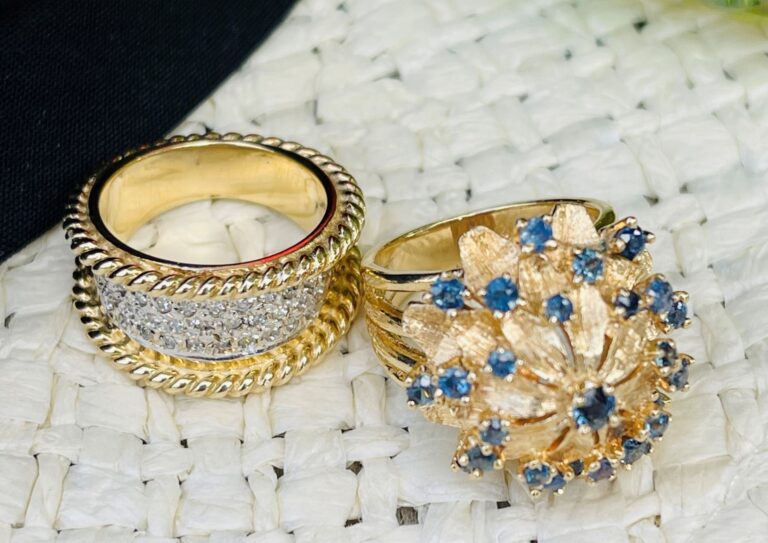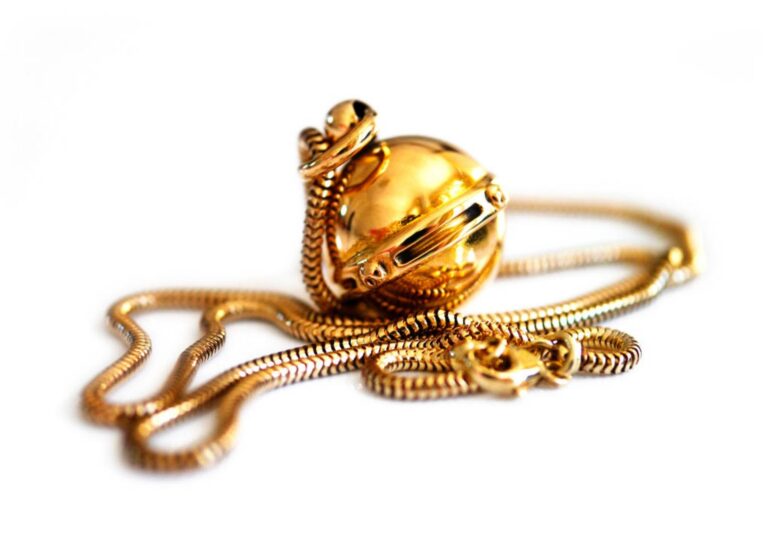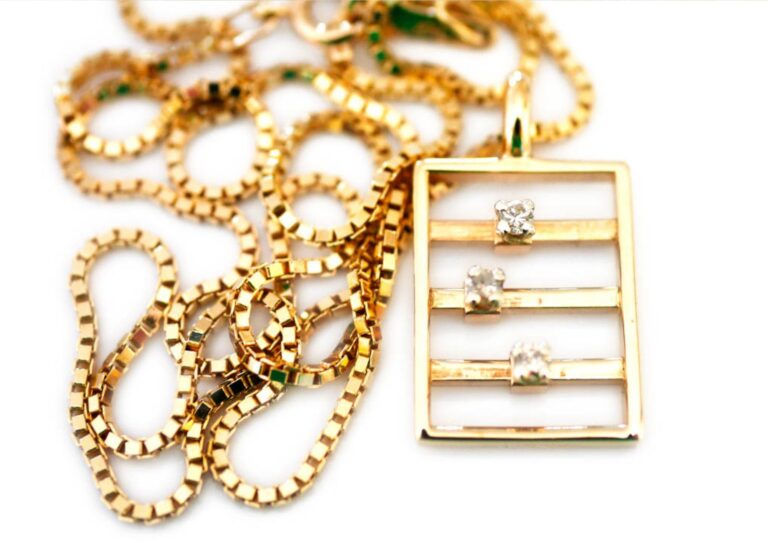A quick glance at the TV listings is all you need to confirm Britain’s obsession with craft. From the Sewing Bee to The Great Pottery Throw Down, and new BBC jewellery show All That Glitters, we are a nation that loves to create and to buy handmade goods.
The British Craft Trade Fair (BCTF) is an annual celebration of designer-makers that has been spotlighting independent craftspeople for more than 45 years. This year’s show, which will run from June 27th to July 1st, will be held virtually – Covid-19 restrictions have put a hold on the physical event, which will return to Harrogate in April next year.
The digital show is aimed at retail buyers seeking craft items that have been handmade in the UK – this is a prerequisite for all participating exhibitors – and features a small cohort of jewellery designer-makers offering costume jewels and fine designs. Retailers can use BCTF Online to source new products by browsing designer profiles, watching videos and engaging in live chats and video calls with makers.
“Whilst I prefer to meet people in the flesh, the world is changing and we must adapt to new ways of trading,” says Nadege Honey, who will use BCTF to showcase her colourful polymer clay jewels that are handmade in Northamptonshire. “Supporting local businesses has always been important to me and handmade has the appeal of being unique, because it is not mass produced. Offering carefully crafted products made in Britain means the buyers can, in turn, support our creativity and champion the vast craftsmanship available in the UK.”
Meet the jewellery designers taking part in BCTF Online 2021
Olivia Jeffries
Armed with vintage tools and a gas torch, Olivia Jeffries wields silver to her will in her workshop in Norwich. The designer finds inspiration in organic textures and this is reflected in the tactile silver jewels she creates. The designs, which include blackened silver earrings and hand-forged chains, have an industrial edge to them. This morphing of masculine details and feminine curves makes for jewels that could easily be genderless. “These pieces appeal to those who adore the beauty and duality of an object being both timeworn yet modern,” says Olivia, whose work is stocked at stores including Craftco in Suffolk and Jill Smith’s Studio in Norfolk. “Although visually raw in places, each piece is thoroughly polished to ensure it is soft, wearable and sits in harmony with the body.”
Dormouse Designs
Colourful jewellery has been a buoyant trend over the past year or two, and Dormouse Designs is all about chasing the rainbow. Through specially selected gemstones such as rutilated golden quartz, amethyst, lapis lazuli and Tahitian pearls, designer Caroline Gallup brings a blast of chromaticity to the jewellery collections. Gallup, who bases herself in the leafy village of Wooburn Green in Buckinghamshire, is inspired by the natural world. As well as shaping the motifs she works with, her love of nature has also led her to seek sustainably sourced raw materials including Fairtrade gold. “When you enter the Dormouse Jewellery world, by zoom or in person, you will find beauty, benefit and value in everything you see,” says Caroline. “My handcrafted jewellery is a true celebration of what nature has taken generations to create, so that the generations to come can enjoy it. My philosophy is to nurture a personalised experience, putting my clients at the heart of the design process.”
Camilla West
Ask Camilla West what her favourite gemstone is and you’ll get a long list. Ultimately, she’ll land on labradorite, but you’ll probably hear her mention tourmalines, sapphires and garnets. The Tonbridge jeweller works to showcase the best proportions of these natural gems, attaching irregular-cut stones to delicate gold-filled chains to create wearable threaded earrings, or championing single faceted gems as cocktail rings. “I design my jewellery to evoke nature and organic patterns and textures and to speak to people’s emotions,” says Camilla, who crafts her jewels in a studio in Weald of Kent overlooking a deer park filled with ancient oaks and chestnut trees. “I feel it is important to leave a trace of the maker on the finished piece – the slight irregularities are part of what gives the jewellery its character and makes it different to something mass produced. They also echo the small irregularities in natural and organic patterns.”
Elsiem Jewellery
Before turning her attention to smaller crafts, Lorraine Hitt designed furniture and architectural interiors. The discipline she picked up during her 30-year career in the design world clearly leaves its mark on the bold, structural jewels she creates under her Cambridge-based brand Elsiem Jewellery. Statement earrings, cuffs and colliers cut a striking figure through a palate of black and gold. The golden metal is hand-finished brass, while the black elements have been 3D printed in nylon before being vibro-polished and dyed. “My jewellery is inspired by my love of simple visual and architectural forms, incorporating functionality and practicality,” says Lorraine, who started first making jewellery in 2016. “I am always learning and evolving techniques and materials to keep my work fresh and innovative.”
Nadege Honey Design
Looking at the bold blue-and-white stripes and flashes of orange and yellow in Nadege Honey’s Breton collection, it is impossible not to be spiritually transported to the Brittany holidays of her childhood that so inspired the designer. Working by hand in her studio in Northamptonshire, Honey uses silver and polymer clay to create her distinctive, colourful jewellery designs. Graphic shapes and bold patterns weave through all the brand’s designs, with other collections taking inspiration from the Art Deco movement, flowers and sea life. “I create pieces where colour, pattern and texture are centre stage,” says Nadege, who recently launched a line of notebooks and greetings cards inspired by her jewels. “Sketching a new design and mixing the clay to obtain the exact shade I am after, are two of my favourite steps in the process of creating jewellery.”
Anna Roebuck
Artist Anna Roebuck is a maker with a purpose; her jewels are designed to make you stop and think. For more than 18 years, she has been working with recycled materials and her latest collection tackles a very topical environmental issue – plastics. The colourful Nocean jewellery collection is made from recycled plastic bottles, which she collects locally in Burton-on-Trent and recycles at her own studio. The material is then dyed and paired with copper or aluminium to create bold jewels. “I trained in Fine Art Tapestry at Edinburgh College of Art in the 90s and this was where my fascination with reusing and recycling began,” says the designer, who has also launched the Out of Line collection of jewels salt-engraved with her own illustrations. “I created installation-based artwork using all sorts of mediums, from plastic bags and rusty metal to mud and blood. My work at the time explored the interaction between man and nature, and though there have been many changes along the way, the interest in how we interact with our environment has always been key to what I do.”
Janet Leitch
Often the question will arise of whether you are a silver person or a gold person. With Sheffield jewellery designer Janet Leitch, no choice is necessary as her pieces beautifully blend both precious metals. Janet, who spent 30 years teaching design and technology before returning to an early love of jewellery making, uses the ancient Korean gilding technique of Keum Boo to mix her metals. Some designs have been oxidised to further accentuate the contrast. “My inspirations for my textures are taken from my surroundings, both natural and manmade,” she says, who has designed a new collection of earrings tailored to those who now have longer lockdown locks. “My pieces are always developed to enhance the texture. It has often been described as ‘classy but edgy’ – a line I continue to use.”
ContraryMary Designs
Etching, piercing, fold-forming, shell-forming, anticlastic raising… these are just some of the techniques that Wakefield jewellery designer Mary Duggan uses to create her ContraryMary Designs silver jewellery collections. Or as she describes it, to “forge metal with soul”. Nature is a key inspiration point for the jeweller, with leaves, pebbles and shells frequently popping up in her creations. Some of the designs, including her stackable Confetti rings and delicate Willoleaf earrings, are accented with gold. “I am inspired by organic forms and textures,” says Mary, who works with both sterling silver and tarnish-resistant Argentium silver. “The pure abstraction of fractal forms is used in some pieces – I am fascinated by the way that these algebraic expressions produce flowing organic forms that relate closely to the natural world.”


